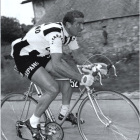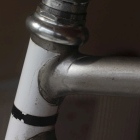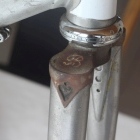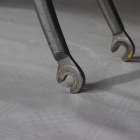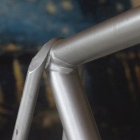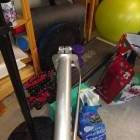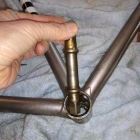
Carpano Team Bike or French Mystery Frameset
First a little bit of Cycling History
Carpano were an Italian Cycling Team founded in 1956 by Fausto Coppi (one of the truly great cyclists) late in his career after he was sacked by Bianchi, ostensibly for breaking his contract but in reality because he had offended the morality of staunchly catholic Italy by, as a married man, having an openly public affair with the wife of a fan (La Dame Bianca). Coppi brought Carpano (a wine company) in as a joint sponsor for the first two years and then parted ways as Carpano took sole sponsorship. At that stage they adopted a black & white striped livery (the team owner was a fan of Juventus fottball club and the jerseys were similar. Carpano continued as sole sponsor until 1964. See Wikipedia for more.
Carpano was the second most successful team during it"s existence, the winner of the 1960 Tour de France (riding for the Italian National Team) Gastone Nencini, was a Carpano cyclist, the belgian cyclist Gilbert Desmet was 4th in the 1962 Tour de France riding for Carpano. They also had two overall wins in the Giro d"Italia (1962 & 1963) with Franco Balmamion. The team, although Italian, seemed to run two squads and had many Belgian/Dutch cyclists and competed in the low countries as well as Italy, France, Switzerland, and Spain.
Now before I bought the frameset, I knew nothing of this. I had read a book about Coppi, so knew of his achievements and the scandal in his life, but had never before heard/recalled of Carpano or the other cyclists and achievements.
Now, lets move on to the Now.
How it came about that I bought the frameset (My Covid 2021 Contingency Project)
We were approaching the 2nd year of the Covid-19 pandemic. During the first year, I had built/restored 5 bikes in varying guises from old to not so old, for myself and for two daughters. Some of these projects had been lying around for a few years and might never have been done if not for the pandemic and lockdowns. I also had bought some bits and pieces and saved up a few projects for the 2nd year - a full bike build, some groupset upgrades, and some re-arranging of components between bikes. But I was aware that I might not have enough projects in the event that the pandemic would continue with intermittent lockdowns.
So, I was keeping a watchful eye out on eBay, something cheap and interesting. As Brexit had happened, I was also watching eBay France in addition to eBay UK. Thats when I spotted "Cadre Velo Campagnolo" (Bike Frame Campagnolo). Now Campagnolo never made bikes and it was evident the seller called it Campagnolo because that was the only identity on the frame - the "brev (made by) Campagnolo" on the forged dropouts which held the rear wheel. Campagnolo made lots of these dropouts and they were used by many bike manufacturers, but they were usually an indication of a good quality bike. But this wasn't the only thing that appealed, the frame lugs (sleeve that overlap the frame tube joints) were slightly ornate and had been filed so that they were a smooth transition to the tubes (to me, this was very fine work - craft work and an indication of something special). Also, the seat stays, where they joined the seat tube and top tube lug, were curved so that they part wrapped around the lug (normally these are flat with no wrap around) - again a possible indicator of care and attention. The fork was a beauty, an inscribed "B" on either side of the fork crown and a cut-out Spade (as in the suit of playing cards) on the sides to the crown. This seemed a contradiction to the filing of the frame lugs, so I suspected that the fork may not have been original to the frame.
But there was paltry description, no additional information, other than "good condition" and "from the 70s" and 55cm size (I thought it looked a little smaller). From the photos I could see that the bottom bracket was French Standard threaded (presumably that meant the Fork would also be French Standard) a standard that is obsolete - but not a problem as I had dealt with this before on my Peugeot. And I didn't want to start asking questions in case I opened up the item to the attention of others. So, was it light or heavy, was it good racing tubing or gaspipe junk? However the reserve was low, the postage from France reasonable and there had been no bidders, so I put an eBay watch on the frameset. I did my usual, 4 seconds before the auction time was up, I stuck in my bid - the reserve plus 2 euro, and got it for the reserve price. Then I awaited delivery to see if I'd squandered 105 euro.
What I got
Wow. It was light, very light. It was straight, not bent, almost looked like it had seen no, or little use. The paint was odd, looking like it had been sprayed over bare metal, and some of the silver spray looked like it had been done later and only to parts of the frame. No rust other than tiny bubbles (again looking like it had lain in storage somewhere). Inside the seat tube there seemed to be no recent (if any) sign of a seat post being inserted. The fork, though, definitely had been painted yellow and was poorly oversprayed with silver to match the frame (this only added to the conviction the the fork was not original to the frame). The black & white on the frame is all vinyl stickers (not paint). The striped design on the seat tube is one piece of striped vinyl, the headtube is covered with white vinyl cut to fit around the lugs (looks like it was stuck on and then cut in place with a blade as the cuts can be seen on the frame), then the black band put on over the white. There was no serial number or other markings anywhere on the frame - strange. The frame was my size exactly, 53cm, this was real good. This was Gold - at least to me. From some measurements of the tube diameters, I guessed that the tubes were Reynolds 531 (metric) or Vitus Super 172, and the frame/fork total weight was in this ball park. Delighted was putting it mildly. I should add, the frame is perfectly true (I checked it's alignment using the Sheldon Browne method). The rear dropouts are spaced 120mm (correct for a 60s/70s 5 or 6 speed rear wheel) and the front forks dropouts are spaced 96mm again 60s/70s spaced especially for French bikes). It does look like it may have been unused.
Disassembley (Headset & Bottom Bracket)
I stripped out the headset and removed the Fork, and removed the bottom bracket - to see if there were any other indicators inside. The fork, as suspected was French threaded, but a real surprise was the fork steerer tube it was stamped with "Reynolds 531 Butted 16/13" - so the fork is quality. The Bottom Bracket was pretty straightforward, with the only real problem being the driveside fixed cup (aren't they always?). Non-Drive Side lockring came off easily using an antique tool I've always had (everybody has one), and the NDS bearing cup came off using a longnose pliers (two prongs in 2 of the 4 recessed holes - with a vice grips to give levereage on the pliers. The fixed cup had not enough "edge" for a good grip with a wrench, so I used my home made head set press to compress the wrench onto the fixed cup, and with the help of a wedge to keep the wrench edges parallel to the bb facing, the fixed cup "let go" surprisingly easy (might have been helped by two days worth of WD40 sprayed into the threads from the inside). However, the inside of the bottom bracket shell yielded no information - but at least I now have options for installing a crankset of my choosing (cheap/available/tools I already have).
So, what did I really have?
To kickstart the research, I posted details of the frameset on a couple of Facebook Groups for Vintage Steel Bikes and Mystery Frames, looking for any suggesions. I got some of the "ugly frame", "badly hacked lugs", "looks like it was built by prisoners instead of sewing mailbags" comments - maybe well intentioned but offering no help at all but it appeared that some of the features that interested and impressed me had the opposite effect on others (some people, dare I say it, seem to only like bling and brand names). But I did get a few gems and one particular nugget of information. The nugget was the suggestion that the paint scheme looked like Carpano team bikes and Gastone Nencini's bike when winning the Tour de France in 1960. The gems, were the suggestion the Campagnolo dropouts looked like they were replacements (for whatever reason - to be fair the jointing looked a little rough so I agreed with that assessment) and that the frame looked to be a 1960s frame, and the fork looked like an 80s fork. So, if the dropouts were replacements, and the sellers estimate of 70s was probably based on these as the dropouts only became available in the 70s. And then, if the frame was a 60s frame, it could be contemporaraneous with the Carpano team bikes. This was really getting interesting. A bit of detailed research into Carpano bikes, showed my frameset's decor to be exactly like the Carpano bikes (sripes of 5 black spaced by 4 white) which on my frameset is one piece of vinyl - not individual strips of tape, in other words was made for the frameset.
This is my Carpano directly compared to a Carpano Team Bike. On the left is Nino Defilippis (multi stage winner TdeF and Giro) with his bike and on the right is my frameset as delivered.

Look in detail at the bikes in the Carpano History section for more similarities
Who made the Campano team bikes (the official ones)?
It seems that they were made by Guisseppe Pela, who was a bike builder for the stars. But Ivm not sure if built the all the Carpano bikes. He definitely built one-offs for the top cyclists of the day (Anquetil et al) and he had a deal to supply Carpano bike frames to Raymond Wohlhauser (an upmarket bike shop) in Lyon. He also never put his name on any bike, so bikes now being identified and credited to him are done on circumstantial evidence (unless the bike's history is completely known). But, from what I can see, his bikes are different from mine in some details - Columbus tubing, Italian Standards, and from photos of bikes claiming to be these official team bikes there are a few differences (lugs, style of rear derailleur cable braze on on the chainstay). But the seat stay attachment to seat tube is very similar. I think I need to research this area further - the bikes are too good to be bikes for the whole squad plus spares. Also in some of the squad photos, the head tube black stripe seems to be of inconsistent width, some of the bikes are not even shown with white headtubes - almost as if the team bikes are an assortment of seperate bikes. Leads me to wonder if there were different suppliers of the teams racing bikes, or if the only requirement was to look like a Carpano Team Bike and be silver with black & white livery (the livery being supplied by the team).
That leaves a few outstanding issues :
- French bike for an Italian team? An unlikely situation on the face of it - but a team with a lot of Belgians?
- What possible reason coud there be for a French version of the Carpano Team Bike?
- Is there any significance to the lightening of the lugs? Weight? Appearance?
- Where or what did the fork come from? The inscribed "B" and the Spade cutouts?
- Could Charles Terryn have any imvolvement with the frame? He was a Belgian Mechanic working for Carpano (ex cyclist) who owned a bike shop and went on to contract various builders to build his own brand bikes - some similarities but probably another rabbit hole,
Here are the specs of the frameset - with comments where necessary :
- Frame
- 1960s
- French
- Weight - just below 1700gms (this is pretty light)
- Tubes - most likely Reynolds 531 metric. Could also be Vitus but not if a 60s bike
- Fork
- 1980s maybe - based on fork crown embossing and cutouts
- French - based on threading of fork, but appearance is more Italian
- Weight - 685gms (this is also pretty light)
- Tubes - the steerer tube is Reynolds 531 (stamped on the metal). I assume this means that the remainder of the fork is 531
What to do with it next? aka How should I build it up?
A Caveat : I want to apologise to all perfectionists. This is going to be a cheap Covid project to keep me busy. I will produce a bike that I can ride with minimal cost to me, minimal impact to the existing frame & fork (nothing irreversible), and get a chance to see how good it is on the road. It won't be period correct, but it will have (mostly) quality bits and I'll focus on French parts when purchasing to keep the French theme. So, with that proviso, please read on.
Thinking of not interfering with the frame, i.e. keeping the dropout spacing as is. Spraying the frame with rattle can silver (after some frame prep) but keeping (masking off) the black & white decals and headtube as is. Stripping parts off an 87 Koga Miyata (Shimano 105 1st Gen inc Golden Arrow Crankset and LiteAction Brakes/Derailleurs/Levers), I think the wheels are narrow enough to fit (will check beforehand). That way I can get the bike mobile and start using it while keeping the option of building it period correct and with appropriate bits, if and when I find out it's true provenance. I can purchase a modern (gasp) french threaded bottom bracket with JIS spindle to fit the crankset, and am watching for a suitable seat post on good old eBay. It's a plan anyway, and it meets the requirement of a Covid Lockdown (or restricted) project - keeps me busy and at home.
Having looked in greater detail at this "retromod" build plan, a few hiccups are becoming evident and a few solutions are becoming obvious :
Bottom Bracket The specification of the planned crankset calls for a 122mm bottom bracket (BB) spindle, but the the donor bike is running it on a 115mm spindle (found this out after I removed it), and it fits perfectly with this. So, which length modern french threaded BB should I buy? Get the wrong one and it's an expensive (Euro 40) mistake - and something that I'll probably never reuse. After much measuring, head scratching, and a few change of minds, I have decided to go for the version and specified i.e. the longer 122mm one. This is influenced, mainly, by the observation that the dimple on the Drive Side (DS) Chainstay is in the wrong place for my planned chainset. This dimple is for providing a bit of extra clearance between the chainset and the chainstay, but is positioned where a larger Bolt Circle Diameter (BCD*) than my chainset has. Older chainsets would typically have had larger BCDs than newer ones - so I think (only think) that I will need the extra clearance of a 122mm BB. (* The thickest part of a chainset is where the bolts for the chainrings are fixed, this part and the inner chainring, is the part of the chainset that comes closest to the chainstay - there is normally an indent, or dimple, in the chainstay to allow a for a bit of extra clearance. As this is a 60s bike it would be set for the larger BCD chainsets which were standard at the time).
Brake Caliper The distance between the brake mount holes and the wheel rims are different between the front an the rear. This is likely a result of the fork not being original to the frame and also of being from a later era. That means I cannot use the brake calipers from the donor bike on the rear as they are too short. So, the only solution is to purchase a caliper for the rear which fits. Some very careful measuring of the front and back requirements, and a bit of eBay snooping of possibilities, and a desire to fit some French components where possible, identifies a brakeset that has calipers that have sufficient adjustment that will allow them to fit both front and back. These quickly got added to my shopping list.
Seat Post Being French, I definitely needed to buy a seat post but which size? 26.4, 26.6, or 26.8 - the diameter in mm that it could be, and I didn't have confidence in my measurements of the inner diameter of the seat tube to buy with any degree of confidence. But, I did have a 26.4 in my vintage Peugeot, so I popped this into the frame - surprising, because I thought my measurements suggested I needed wider, it fit perfectly. So, now I added a 26.4 seat post to the shopping list. I found one easily enough on eBay France, but the seller was offering a shipping discount for multiple items, and I spotted a set of French handlebars and more importantly a French standard (i.e. narrow) stem for good money - so I added those to the list. This stem would save me sanding down a non French stem to fit (tiresome and ruining a really good stem I already had) and eliminated all of the shipping cost of the seat post from the deal. The seller also had a set of gear shifters (French made) that I added to the list as they were also free of shipping charge as they were included in the group deal.
So, at this point I have added a little to the cost of the overall build out of (a) necessity, and (b) opportunity/convenience. There is still a cable guide, and possibly a cable stop, that I'll need, but can't make up my mind how much I want to spend, or which of the few options I want to go for. So, this decision is on the long finger while I watch for an opportunity to get a good deal.OK, after writing this I took the plunge a bought a NOS Cable Guide from eBay and will use the Campagnolo Double Cable Stop that came on the frame to solve my Cable Stop problem.
So, Now the spec for the build is becoming more concrete. Here's where I am now (April 2021) :
- Frameset - Frame (1960s) and Forks (1980s?) and Headset as listed above (to be Rattle Can sprayed metalic silver)
- Wheelset - Shimano 105 (1980s) from Koga Miyata (Trim axles where necessary and remove a few spacers)
- Chainset - Shimano 105 Golden Arrow (1980s) from Koga Miyata
- Bars & Stem - ATAX Franco-Italia & Milremo Stem (1980s) from eBay
- Seatpost - J.P. Routens (JPR) 26.4 from eBay (1980)
- Bottom Bracket - Modern Sealed JIS 122mm to fit Chainset
- Brake Levers - Shimano 105 or Lite Action (1980s) from Koga Miyata
- Brake Calipers - CLB GL 48 - 65 (a range that should fit both front and back) from eBay
- Gear Shifters - Simplex Criterium (1970s/80s) from eBay
- Front Derailleur - Shimano Lite Action (1980s) from Koga Miyata (or might fit Shimano 105)
- Rear Derailleur - Shimano Lite Action from Koga Miyata (1980s)
- Saddle - San Marco Corsa - Blue Suede (1980s)(or might use more modern Flite Black/White)
- Accessories - Cable Clips : Aliexpress (Simple Top Tube Clips) & eBay (NOS Huret Bottom Bracket Guide)
- Accessories - Bar Tape & Cables - Plenty lying around will pick something
- Accessories - Bottle Cage Mounts : Gotta leave something up in the ai, after all I am a natural procrastinator
This will truly be a mongrel bike - but will it be a good mongrel or a bad one?
Contact me by email : alan_cowzer@hotmail.com
Contact me through Facebook : My Peugeot CFX-10 Facebook Page
© 2018- 2025 Alan Cowzer






